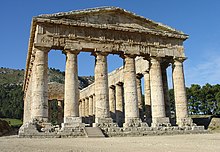Elymer
The Greeks referred to a part of the pre-Greek population of Sicily as Elymer ( ancient Greek wurdeλυμοι Elymoi , Latin Elymi ) . Together with the Sicelians and Sicans, they lived on the island at the time of the great colonization . The Elymers lived particularly in western Sicily. Their most important cities were Eryx (today's Erice ), Segesta (also Egesta ) and Entella . Their settlement area is bordered by the Belice in the east and the line Monte Iato - Partinico - Montelepre in the north.
The exact origin of the Elymers is unclear. Thucydides traces it back to Trojans who, under their leader Elymos, after some wanderings together with some Phocaeans, supposedly settled in the region mentioned, which was previously inhabited by Sicans. According to Virgil's Aeneid, they are said to belong to the Trojans who fled Troy with Aeneas , but then did not move on to Lazio with him . Since Aeneas is considered to be the progenitor of Romulus and Remus , the legendary founders of Rome , after the conquest of Sicily the Romans saw the Elymers as a related people who deserved preferential treatment.
In Virgil 's Elymos Helymus and after Servius he was the founder of the cities Asca , Entella (near the present city of Contessa Entellina ) and Egesta . The names of their cities suggest a Ligurian origin. More recent finds made in the 9th / 8th centuries Century BC BC, but suggest an Italian origin and close ties to the Italians. This is also supported by the latest philological research.
According to Hellanikos , however, the Elymers originally came from southern Italy and were ousted there by the Oinotroi . At the time of the Greek colonization, the Elymers were mostly allied with the Phoenicians and against the Greeks until their Hellenization in the 5th century BC. BC hostile. After the Hellenization, they are no longer mentioned.
So far there is only sparse evidence of the Elymic language , many of which only became known from the 1960s. Initially, people wanted to recognize Ligurian or Illyrian connections here . However, this turned out to be untenable. Apparently the Elymic language is very similar to the Sicelic - that is, an Indo-European language , possibly close to the Italian language group . The existing language certificates were mainly used in the form of graffiti on 600 ceramics in Segesta (8th – 6th centuries BC) and as coin legends on coins from the 5th century BC. Found in Eryx and Segesta.
The Elymers should not be confused with the Iranian Elymeans .
literature
- Giulia Falco: Elymoi. In: The New Pauly (DNP). Volume 3, Metzler, Stuttgart 1997, ISBN 3-476-01473-8 , Sp. 1003.
- Simona Marchesini: The Elymian language. In: Olga Tribulato (Ed.): Language and Linguistic Contact in Ancient Sicily. Cambridge University Press, 2012, pp. 95-114.
Individual evidence
- ^ Thucydides, The Peloponnesian War 6, 2, 3.

